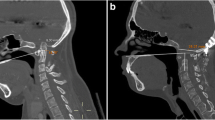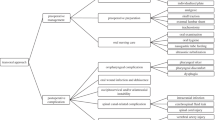Abstract
Background
Odontoidectomy has been considered an effective way to treat anterior cervicomedullary compression in patients presenting with craniocervical joint anomalies. The transoral and transnasal routes have been described for anterior decompression surgery. However, to date, a comprehensive review of the complications from this procedure is lacking in the extant medical literature. Therefore, herein, we review this specific literature as a resource for surgeons.
Methods
A comprehensive review of the literature via online search engines was performed.
Conclusion
The most reported complications for odontoidectomy are CSF leakage, postoperative craniocervical instability, velopharyngeal insufficiency, wound dehiscence, pulmonary issues, meningitis, and death. To our knowledge, this is the first comprehensive review of complications of odontoidectomy. Increased awareness of the more common complications associated with this procedure may help in the care of patients in the future.
Similar content being viewed by others
References
Agrawal D, Gowda NK, Bal CS et al (2006) Have cranio-vertebral junction anomalies been overlooked as a cause of vertebro-basilar insufficiency? Spine (Phila Pa 1976) 31:846–850
Bambakidis NC, Dickman CA, Spetzler RF et al (2012) Surgery of the craniovertebral junction. Thieme, New York
Bao J, Zhang Z, Zhang X (1999) Management of complications of transoral odontoidectomy. 19:397–399
Beech TJ, McDermott AL, Kay AD et al (2012) Endoscopic endonasal resection of the odontoid peg—case report and literature review. Childs Nerv Syst 28:1795–1799
Crockard HA, Pozo JL, Ransford AO et al (1986) Transoral decompression and posterior fusion for rheumatoid atlanto-axial subluxation. J Bone Joint Surg (Br) 68:350–356
Dasenbrock HH, Clarke MJ, Bydon A et al (2012) Endoscopic image-guided transcervical odontoidectomy: outcomes of 15 patients with basilar invagination. Neurosurgery 70:351–359, discussion 359–60
Di Lorenzo N (1992) Craniocervical junction malformation treated by transoral approach. A survey of 25 cases with emphasis on postoperative instability and outcome. Acta Neurochir (Wien) 118:112–116
Dickman CA, Crawford NR, Brantley AG et al (1995) Biomechanical effects of transoral odontoidectomy. Neurosurgery 36:1146–1152, discussion 1152–3
Duntze J, Eap C, Kleiber JC et al (2014) Advantages and limitations of endoscopic endonasal odontoidectomy. A series of nine cases. Orthop Traumatol Surg Res 100:775–778
Fang CH, Friedman R, Schild SD et al (2015) Purely endoscopic endonasal surgery of the craniovertebral junction: a systematic review. Int Forum Allergy Rhinol. doi:10.1002/alr.21537
Gempt J, Lehmberg J, Grams AE et al (2011) Endoscopic transnasal resection of the odontoid: case series and clinical course. Eur Spine J 20:661–666
Goel A (2005) Progressive basilar invagination after transoral odontoidectomy: treatment by atlantoaxial facet distraction and craniovertebral realignment. Spine (Phila Pa 1976) 30:E551–E555
Goldschlager T, Hartl R, Greenfield JP et al (2015) The endoscopic endonasal approach to the odontoid and its impact on early extubation and feeding. J Neurosurg 122:511–518
Hankinson TC, Grunstein E, Gardner P et al (2010) Transnasal odontoid resection followed by posterior decompression and occipitocervical fusion in children with chiari malformation type I and ventral brainstem compression. J Neurosurg Pediatr 5:549–553
Hickman ZL, McDowell MM, Barton SM et al (2013) Transnasal endoscopic approach to the pediatric craniovertebral junction and rostral cervical spine: case series and literature review. Neurosurg Focus 35:E14
Jain V, Behari S, Banerji D et al Transoral decompression for craniovertebral osseous anomalies: perioperative management dilemmas. Neurol India 188
Kahilogullari G, Meco C, Zaimoglu M et al (2015) Pneumocephalus after endoscopic odontoidectomy in a pediatric patient: the lesson learned. Childs Nerv Syst. doi:10.1007/s00381-015-2740-4
Kassam AB, Snyderman C, Gardner P et al (2005) The expanded endonasal approach: a fully endoscopic transnasal approach and resection of the odontoid process: technical case report. Neurosurgery 57:E213, discussion E213
Lee H, Kim J, Tagmazyan K (2013) Treatment of stable chronic obstructive pulmonary disease: the GOLD guidelines. Am Fam Physician 88:655–663, 663B-F
Liu JK, Patel J, Goldstein IM et al (2015) Endoscopic endonasal transclival transodontoid approach for ventral decompression of the craniovertebral junction: operative technique and nuances. Neurosurg Focus 38:E17
Marda M, Pandia MP, Rath GP et al (2013) Post-operative pulmonary complications in patients undergoing transoral odontoidectomy and posterior fixation for craniovertebral junction anomalies. J Anaesthesiol Clin Pharmacol 29:200–204
Messina A, Bruno MC, Decq P et al (2007) Pure endoscopic endonasal odontoidectomy: anatomical study. Neurosurg Rev 30:189–194, discussion 194
Morales-Valero SF, Serchi E, Zoli M et al (2015) Endoscopic endonasal approach for craniovertebral junction pathology: a review of the literature. Neurosurg Focus 38:E15
Naderi S, Crawford NR, Melton MS et al (1999) Biomechanical analysis of cranial settling after transoral odontoidectomy. Neurosurg Focus 6:e7
Naderi S, Pamir MN (2001) Further cranial settling of the upper cervical spine following odontoidectomy. Report of two cases. J Neurosurg 95:246–249
Patel AJ, Boatey J, Muns J et al (2012) Endoscopic endonasal odontoidectomy in a child with chronic type 3 atlantoaxial rotatory fixation: case report and literature review. Childs Nerv Syst 28:1971–1975
Ponce-Gomez JA, Ortega-Porcayo LA, Soriano-Baron HE et al (2014) Evolution from microscopic transoral to endoscopic endonasal odontoidectomy. Neurosurg Focus 37:E15
Qasho R, Lunardi P, Mancinelli I et al (1998) Peduncular hallucinosis following a transoral odontoidectomy for cranio-vertebral junction malformation. A case report. J Neurosurg Sci 42:47–49
Qiuhang Z, Feng K, Bo Y et al (2013) Transoral endoscopic odontoidectomy to decompress the cervicomedullary junction. Spine (Phila Pa 1976) 38:E901–E906
Scalici E, Indorato F, Portelli F et al (2014) A fatal iatrogenic right vertebral injury after transoral odontoidectomy and posterior cervical stabilization for a type II odontoid fracture. J Forensic Legal Med 22:41–44
Tuite GF, Veres R, Crockard HA et al (1996) Pediatric transoral surgery: indications, complications, and long-term outcome. J Neurosurg 84:573–583
Van Abel KM, Mallory GW, Kasperbauer JL et al (2014) Transnasal odontoid resection: is there an anatomic explanation for differing swallowing outcomes? Neurosurg Focus 37:E16
Visocchi M, Trevisi G, Iacopino DG et al (2015) Odontoid process and clival regeneration with chiari malformation worsening after transoral decompression: an unexpected and previously unreported cause of “accordion phenomenon”. Eur Spine J 24(Suppl 4):564–568
Yadav YR, Madhariya SN, Parihar VS et al (2013) Endoscopic transoral excision of odontoid process in irreducible atlantoaxial dislocation: our experience of 34 patients. J Neurol Surg A Cent Eur Neurosurg 74:162–167
Conflict of interest
The authors report no conflict of interests.
Author information
Authors and Affiliations
Corresponding author
Rights and permissions
About this article
Cite this article
Tubbs, R.S., Demerdash, A., Rizk, E. et al. Complications of transoral and transnasal odontoidectomy: a comprehensive review. Childs Nerv Syst 32, 55–59 (2016). https://doi.org/10.1007/s00381-015-2864-6
Received:
Accepted:
Published:
Issue Date:
DOI: https://doi.org/10.1007/s00381-015-2864-6




